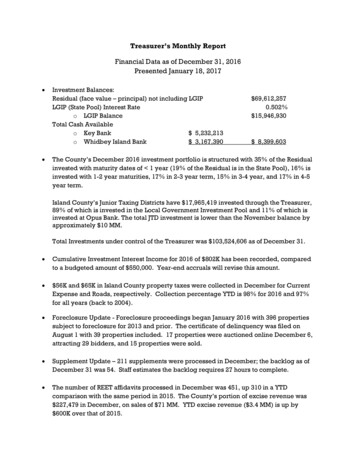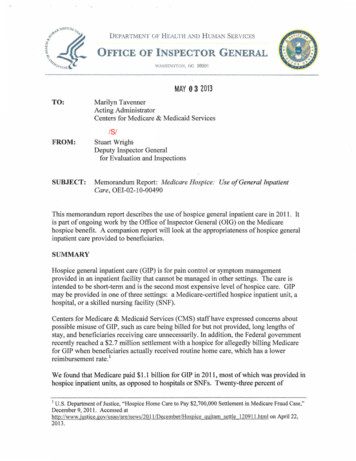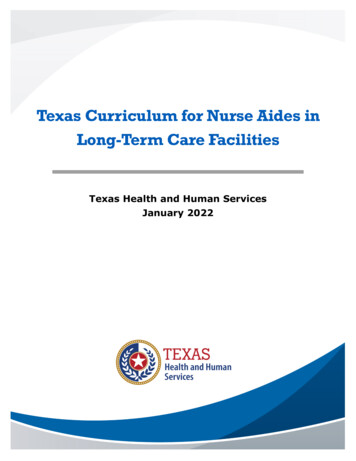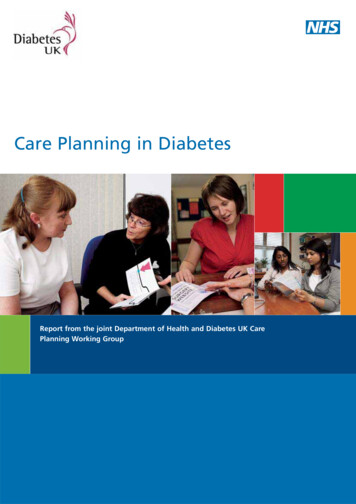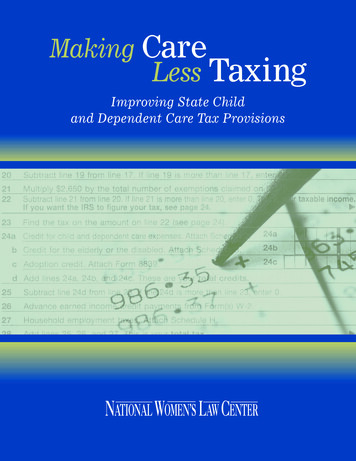
Transcription
Making CareLess TaxingImproving State Childand Dependent Care Tax ProvisionsNATIONAL WOMEN’S LAW CENTER
The National Women’s Law Center is a non-profit organization that has been working since 1972 to advance and protectwomen’s legal rights. The Center focuses on major policy areas of importance to women and their families, including employment,education, reproductive rights and health, family support and income security—with special attention given to the needs oflow-income women. Janice Steinschneider, the principal author of this report when it was first published in 1994, is a Washington,D.C. attorney experienced in women’s economic and reproductive health issues. Elisabeth Hirschhorn Donahue, who updated thisreport in 1998, is an attorney experienced in child care and child support issues and former Staff Counsel at the National Women’sLaw Center. Nancy Duff Campbell is Co-President and Verna L. Williams is Senior Counsel at the National Women’s Law Center. Copyright 1998National Women’s Law Center
Making CareLess TaxingImproving State Childand Dependent Care Tax ProvisionsJanice SteinschneiderElisabeth Hirschhorn DonahueNancy Duff CampbellVerna L. WilliamsApril, 1998NATIONAL WOMEN’S LAW CENTER
Table ofContentsI. Policies Served by Child and Dependent Care Tax Provisions . . . . . . . . . . . . . . . . . . . . . . . . . . . . . . . . .5II. The Federal Child and Dependent Care Tax Credit . . . . . . . . . . . . . . . . . . . . . . . . . . . . . . . . . . . . . . . . .8III. State Child and Dependent Care Tax Provisions: An Overview . . . . . . . . . . . . . . . . . . . . . . . . . . . . . . .10IV. Designing State Child and Dependent Care Tax Provisions: Issues and Choices . . . . . . . . . . . . . . . . . . .13A. Should States Enact CADC Tax Provisions? . . . . . . . . . . . . . . . . . . . . . . . . . . . . . . . . . . . . . . . . . .13B. Linkage to the Federal CADC Credit . . . . . . . . . . . . . . . . . . . . . . . . . . . . . . . . . . . . . . . . . . . . . . .14C. Targeting Assistance to Lower-Income Families . . . . . . . . . . . . . . . . . . . . . . . . . . . . . . . . . . . . . . . .161. Credits versus Deductions . . . . . . . . . . . . . . . . . . . . . . . . . . . . . . . . . . . . . . . . . . . . . . . . . . . .172. Refundability . . . . . . . . . . . . . . . . . . . . . . . . . . . . . . . . . . . . . . . . . . . . . . . . . . . . . . . . . . . . . .183. Sliding Scales and Maximum Income Limits . . . . . . . . . . . . . . . . . . . . . . . . . . . . . . . . . . . . . .18D. Coverage for Both Children and Adults . . . . . . . . . . . . . . . . . . . . . . . . . . . . . . . . . . . . . . . . . . . . . .20E. Expense Limits . . . . . . . . . . . . . . . . . . . . . . . . . . . . . . . . . . . . . . . . . . . . . . . . . . . . . . . . . . . . . . . .21F. Coverage for Both In-Home and Out-of-Home Care . . . . . . . . . . . . . . . . . . . . . . . . . . . . . . . . . . .22G. Indexing for Inflation . . . . . . . . . . . . . . . . . . . . . . . . . . . . . . . . . . . . . . . . . . . . . . . . . . . . . . . . . . . .23H. Forms . . . . . . . . . . . . . . . . . . . . . . . . . . . . . . . . . . . . . . . . . . . . . . . . . . . . . . . . . . . . . . . . . . . . . . . .23I. Filing Requirements for Married Couples . . . . . . . . . . . . . . . . . . . . . . . . . . . . . . . . . . . . . . . . . . . . .25J. Residency . . . . . . . . . . . . . . . . . . . . . . . . . . . . . . . . . . . . . . . . . . . . . . . . . . . . . . . . . . . . . . . . . . . . .25V. Conclusion . . . . . . . . . . . . . . . . . . . . . . . . . . . . . . . . . . . . . . . . . . . . . . . . . . . . . . . . . . . . . . . . . . . . . .26VI. Appendix . . . . . . . . . . . . . . . . . . . . . . . . . . . . . . . . . . . . . . . . . . . . . . . . . . . . . . . . . . . . . . . . . . . . . . . .27N AT I O N A L W O M E N ’ S L AW C E N T E R3
4N AT I O N A L W O M E N ’ S L AW C E N T E R
Making CareLess TaxingImproving State Child and Dependent Care Tax ProvisionsPaying for care for children or adult dependents takes a big bite out of manyfamilies’ already limited budgets. Yet without such care, married-couple and single-parent families alike have difficulty entering or remaining in the labor force.As a result, families across the country are caught in a bind: finding the financial resources to pay for the child and dependent care necessary for them to earna living. The tax codes of the federal government and about half the states provide some assistance to families in meeting their employment-related careexpenses. However, many states provide little or no tax assistance to familiesstruggling to pay for the care that is so essential to their economic well-being.This report is designed to help state policymakers and advocates rectifythis situation and assist them in developing the best child and dependent care(CADC) income tax provisions possible for their states. By analyzing andevaluating tax policies relating to care for children and adult dependents, thisreport can help states lacking such provisions enact them, and help other statesimprove CADC provisions already on the books. The report reviews the reasons supporting enactment of CADC tax provisions; describes the federal childand dependent care tax credit, which serves as the basis for many state provisions; and provides an overview of the state CADC tax provisions in effect fortax year 1997.1 Finally, the report identifies policy decisions commonly madewhen enacting and implementing a CADC income tax provision and makesrecommendations designed to help policymakers and advocates identify andpursue the best decisions for families.The tax codes of thefederal governmentand about half thestates provide someassistance to familiesin meeting theiremployment-relatedcare expenses.I. Policies Served by Child and Dependent Care Tax ProvisionsThere are a number of good reasons to adopt CADC income tax provisions. Assistance for Families with Large Employment Expenses: Many families have employment-related care expenses that put a severe strain on the1/ A “report card” grading state child and dependent care tax provisions according to a point system basedon the best state policies, Making the Grade for Care: Ranking State Child and Dependent Care Tax Provisions,accompanies this report.N AT I O N A L W O M E N ’ S L AW C E N T E R5
family budget.2 Indeed, families with a preschool-age child who pay forcare spend between 6 and 25 percent of their family income on childcare3—comparable to the 12.5 percent of their family income spent onfood.4 The average weekly cost of care for families with a preschool-agechild who pay for care was 79—or 4,100 per year, in 1993.5 Employment-related care expenses for adult dependents can also be very high. Theaverage cost of adult day care varied from a low of 16.50 per day in NewHampshire to a high of 54 per day in California in 19956— 4,290 and 14,040 a year, respectively. Many families simply do not have the financialresources to pay for care of children or adult dependents; as a result,the cost of employment-related care keeps many individuals out of thejob market. Equitable Income Tax Treatment of Families: Treating taxpayers according to their ability to pay is a cornerstone of tax fairness. A family thatearns 25,000 a year but must spend 3,000 for child care in order to earnthat income has less available income than a family that earns 25,000 andhas no employment-related expenses. Because employment-related careexpenses can cut deeply into a family’s income, CADC tax provisions recognize that a family with such expenses should pay less tax than a familywith the same income but no employment-related care expenses. The federal tax code recognizes a number of large, employment-related expenses—such as office furnishings, automobiles used in a trade or business and business meals and entertainment—and excludes them, or a portion of them,from taxed income. CADC tax provisions apportion tax liability more equitably among families and embody the important principle that employment-related care expenses are a genuine cost of earning income.2/ Seventy-two percent of mothers of children under age eighteen, 65 percent of mothers of children underage six, and 62 percent of mothers of children under age three are in the labor force. Bureau of LaborStatistics, U.S. Dep’t of Labor, Current Population Survey, Marital and Family Characteristics of the LaborForce, Table 15 (March 1997). Although there are not reliable data on the number of individuals in the laborforce with dependents unable to care for themselves, an estimated 25 percent of workers—52 percent ofwhom are women—care for spouses, relatives or friends age sixty-five or older. James T. Bond et al., Familiesand Work Institute, National Study of the Changing Workforce, 1997 (1998).3/ Lynn M. Caspar, U.S. Dep’t of Commerce, What Does it Cost to Mind Our Preschoolers?, Table 3 (1995).The burden on lower-income families is especially great: 25 percent of family income is spent on child careby families with incomes under 14,000, whereas 6 percent of family income is spent by families withincomes of 54,000 and over. Id.4/ Bureau of the Census, U.S. Dep’t of Commerce, Statistical Abstract: 1997, Table 714, Col. 3 (1997) (tabulating average annual expenditures of married-couple families whose oldest child is six years old or younger).5/ Caspar, supra note 3, figure 2. In 1990, the most recent year for which data are available, the averagecost of care for a child age five to twelve years old was 1,900 per year, or a little over half of the average costof care for a preschooler that year. Sandra L. Hofferth et al., National Child Care Survey, 1990, at 145 (1991).6/ Charlene Harrington et al., 1995 State Data Book on Long Term Care: Program and Market Characteristics33, 133 (1996). These average costs are based on Medicaid reimbursement rates and vary from state to state.Adult day care programs generally provide health, social, personal care, and related support services for functionally or mentally impaired adults.6N AT I O N A L W O M E N ’ S L AW C E N T E R
Higher Quality Care: All children and adults unable to care for themselvesneed care that protects their well-being and promotes their development.Such higher quality care costs more money.7 Care payments go towardmaking facilities safe and providing activities, equipment, and staff ratiosthat promote children’s and adults’ development. Another key factor inquality care is maintaining low staff turnover, which is only possible whencare workers are paid a salary that reflects their education, experience, andskills.8 Tax code provisions that put more money in families’ hands foremployment-related care expenses help them to purchase better care fortheir children and other dependents. Equity for Women: Women continue to bear the bulk of responsibility forcare of children and adult dependents. Tax code provisions that assistwomen in paying for care for children and adult dependents take some ofthe burden off women and lessen barriers to women’s participation in theworkforce, enabling them to support themselves and their families.Assistance with employment-related care is especially important for singlemothers, who are more likely to be poor than married couples or singlefathers.9 In addition, by enabling families to pay more for care, CADC taxprovisions can raise the income of child and dependent care workers, whoare mostly women and are grossly underpaid.10Families with apreschool-age childspend between 6 and25 percent of theirfamily income on7/ For example, in 1990, the most recent year for which data are available, the average cost of child care infull-day, full-year, center-based programs for four-year-olds accredited by the National Association for theEducation of Young Children was 4,797. U.S. General Accounting Office, Early Childhood Education: WhatAre The Costs of High Quality Programs? (1990).child care.8/ The average annual salaries for child care workers in 1996 ranged from 6,136 for the lowest-paid family child care providers to 13,156 for the highest-paid child care center workers. Bureau of Labor Statistics,U.S. Dep’t of Labor, Current Population Survey (1996) (unpublished survey, available from the Bureau ofLabor Statistics). Between 1991 and 1992, the most recent year for which data are available, the turnover ratefor child care workers was 26 percent—nearly three times the annual rate of 9.6 percent reported by all U.S.companies and well above the 5.6 percent rate reported for public school teachers. Child Care EmployeeProject, The National Child Care Staffing Study Revisited 10 (1993).9/ For 1996, the median income of families with children headed by a woman was 16,389, well below themedian income of 26,501 of families with children headed by a man and the median income of 51,768 ofmarried-couple families with children. Bureau of Census, U.S. Dep’t of Commerce, Historical IncomeTables-Families, Table F-10 (1997). Moreover, 42 percent of families with children headed by a woman werepoor in 1996, compared to 20 percent of families with children headed by a man and 7.5 percent of marriedcouple families with children. Bureau of Census, U.S. Dep’t of Commerce, Current Population Reports,Series P 60-198, Poverty in the United States: 1996, Table C3 (1997).10/ The child care workforce is 98% female. Dan Bellm et al., National Center for the Early ChildhoodWorkforce, Making Work Pay in the Child Care Industry 13 (1997). Child care workers earn, on average, farless than the per capita median income for all workers ( 18,136 in 1996), Bureau of Census, U.S. Dep’t ofCommerce, Current Population Reports, Series P 60-197, Money Income in the United States: 1996, Table B12 (1997), and less than the average earnings for bus drivers ( 20,600), garbage collectors ( 20,500), or bartenders ( 16,000), Bureau of Labor Statistics, U.S. Dep’t of Labor, supra note 8.N AT I O N A L W O M E N ’ S L AW C E N T E R7
II. The Federal Child and Dependent Care Tax CreditThe federal tax code has had a child and dependent care tax credit since1976, usually referred to as the dependent care credit.11 Under the credit, a portion of employment-related expenses is subtracted from the taxpayer’s federaltax liability to reduce the amount of tax actually owed the federal government.The federal credit is important to state CADC tax provisions for two reasons.First, most states’ CADC tax provisions are tied to the federal credit, usingsome or all of the provisions of the federal credit to determine the state taxbenefit. Second, the federal credit can serve as a model for states to developCADC tax provisions that are independent of the federal provision.The federal credit has the following key features: Employment-related expenses for both children and adult dependentsare covered. Under the federal credit’s current provisions, employmentrelated expenses12 for the care of children under the age of thirteen who livewith the taxpayer may be claimed. Formerly, expenses for children underage fifteen were covered; Congress lowered the age limit for tax yearsbeginning in 1989. Also eligible for the credit are employment-relatedexpenses for the care of spouses and dependents age thirteen and older wholive with the taxpayer and are incapable of self-care. Care both in and out of the home is covered. The federal law allows families to claim the tax credit for both in-home and out-of-home care arrangements. A limitation is that expenses for out-of-home care for spouses anddependents age thirteen and older who are incapable of self-care may beclaimed only if the spouse or dependent spends at least eight hours a day inthe taxpayer’s household. This prevents families from receiving the creditfor institutional care.13 Expenses eligible for the credit are limited. Families may claim workrelated expenses of up to 2,400 for one child or dependent, and up to 4,800 for two or more children or dependents. Any expenses above theseamounts are not eligible for the credit.1411/ The origin of the credit was a 1954 provision establishing a tax deduction for certain employmentrelated child and dependent care expenses. The deduction was converted to a credit in 1976. The current federal CADC credit is found at 26 U.S.C. § 21.12/ Employment-related expenses are expenses incurred while the taxpayer is gainfully employed or inactive search of gainful employment. If the taxpayer is married, the taxpayer’s spouse must also be employedor looking for employment, unless the spouse is a full-time student or incapable of self-care.13/ In addition, expenses paid to a “dependent care center,” defined as a facility that provides care for morethan six individuals, may be claimed only if the center complies with applicable state and local laws.14/ In addition, the expenses claimed may not exceed the earned income of the taxpayer or the taxpayer’sspouse, whichever is less.8N AT I O N A L W O M E N ’ S L AW C E N T E R
The credit targets the greatest amount of assistance to lower-incomefamilies. Only a portion of eligible expenses may be taken as a credit, theportion dropping on a sliding scale as the taxpayer’s income rises, from 30percent to 20 percent. The following chart illustrates the maximum creditamounts at different income levels: AdjustedGrossIncomePercent ofExpensesCreditedOneChild/DependentTwo or MoreChildren/Dependents0 - 10,00010,001 - 12,00012,001 - 14,00014,001 - 16,00016,001 - 18,00018,001 - 20,00020,001 - 22,00022,001 - 24,00024,001 - 26,00026,001 - 28,00028,001 30%29%28%27%26%25%24%23%22%21%20% 720696672648624600576552528504480 960 Married couples must file a joint return to be eligible for the credit. Thisrule does not apply to legally separated married couples, or certain marriedindividuals who are living apart from their spouse and providing over halfthe cost of maintaining their own home.The federaldependent care taxcredit is the singleThe federal CADC income tax credit is the single largest source of federalchild care assistance. According to preliminary data, 6.2 million taxpayersclaimed the federal CADC credit and received over 2.7 billion in tax benefitsin 1995.15 There are, however, a number of features of the federal credit thatundermine its value to families with employment-related care expenses, particularly those with lower incomes.largest source offederal child careassistance. The federal credit is not refundable.16 This means that families who qualify for a credit that is larger than their tax liability receive only a portion ofthe credit—up to the amount of tax owed—for which they are eligible. Forexample, a family that qualifies for a credit of 600 but only owes 400 intaxes will receive a credit of only 400. If the credit were refundable, thefamily would receive a tax refund of 200. The credit’s nonrefundabilityaffects primarily those families who owe relatively little tax—typically families with more limited income whose need for assistance with employmentrelated care expenses may be the greatest. Families whose income is so lowthat they owe no tax receive no federal credit at all.15/ House Committee on Ways and Means, 104th Cong., 2d Sess., 1996 Green Book 812, Table 14-15(Comm. Print 1996).16/ The federal tax provision making the federal CADC credit nonrefundable is at 26 U.S.C. § 26.N AT I O N A L W O M E N ’ S L AW C E N T E R9
Over time, fewer and fewer families receive the benefit of the credit’slow-income targeting because the credit is not refundable and becausethe sliding scale thresholds are not indexed for inflation. The dollaramounts of basic tax provisions that determine tax liability—for instance,the personal exemption, the standard deduction, and the earned incomecredit—were indexed for inflation in 1986. Because the CADC credit’ssliding scale thresholds are not indexed for inflation, however, the targetingto lower-income families provided by the sliding scale has been eroding asfewer and fewer families have incomes low enough to claim the credit’shighest percentages of expenses. For example, for tax year 1997 the taxthresholds for all married couples and heads of household with children areabove 10,000, the thresholds for heads of household with two or morechildren or dependents are above 12,000, and the thresholds for marriedcouples with two or more children or dependents are above 16,000. Asthese examples illustrate, there are virtually no families eligible for thehighest credits of 30-26 percent of their expenses, since even families withonly one or two children or dependents do not pay taxes at the income levels eligible for these percentages. Without refundability or indexing of thesliding scale, both the availability of the credit and its low-income targetingwill continue to erode over time. The dollar expense limits do not reflect the cost of care. When the current expense limits were set in 1981, they reflected the average costs ofchild care. But they have not been updated since, and are not indexed forinflation. Moreover, they have always been inadequate to cover the highcost of adult day care. As a result, the expense limits of the credit are notreflective of many families’ actual care expenses.III. State Child and Dependent Care Tax Provisions: AnOverviewTwenty-four states (including the District of Columbia) have CADCincome tax provisions.17 These provisions may be credits, which, like the federal17/ These states are Arkansas, Colorado, Delaware, the District of Columbia, Hawaii, Idaho, Iowa, Kansas,Kentucky, Louisiana, Maine, Maryland, Massachusetts, Minnesota, Montana, Nebraska, New Mexico, NewYork, North Carolina, Ohio, Oklahoma, Oregon, South Carolina and Virginia. Two more states—RhodeIsland and Vermont—calculate state income taxes as a percentage of federal tax liability, and so indirectlyhave a CADC provision. Sixteen states have a personal income tax but no CADC provision—Alabama,Arizona, California, Connecticut, Georgia, Illinois, Indiana, Michigan, Mississippi, Missouri, New Jersey,North Dakota, Pennsylvania, Utah, West Virginia, and Wisconsin. Seven states—Alaska, Florida, Nevada,South Dakota, Texas, Washington, and Wyoming—have no personal income tax and two states—NewHampshire and Tennessee—tax only certain non-wage personal income. Alaska, although it does not have apersonal income tax, has statutory authority for a refundable CADC tax credit of 16 percent of the federalcredit, subject to “an appropriation for that purpose.” Alaska Stat. §43.20.013 (1997). A telephone call to theAlaska Department of Revenue in March of 1998 yielded the response that CADC tax refunds are not currently available in the state.10N AT I O N A L W O M E N ’ S L AW C E N T E R
credit, are amounts offset against state tax liability to reduce the amount ofstate tax owed. Or these provisions may be deductions, which reduce theamount of income subject to the state tax and ultimately reduce the amount ofstate tax owed.Most state CADC provisions are dependent on or tied to the federal credit,meaning that the taxpayer’s state credit or deduction is determined by some orall of the provisions of the federal credit. A few states have CADC provisionsthat are not tied to the federal credit. Fourteen states provide a tax credit whose amount is determined by the amountof the federal credit that the taxpayer is eligible to receive. The states with thistype of provision are Arkansas, Colorado, Delaware, the District ofColumbia, Iowa, Kansas, Kentucky, Louisiana, Maine, Minnesota,Nebraska, New York, Ohio, and Oklahoma. Typically, the state credit is apercentage of the federal credit.18 Although this type of provision is thesimplest to calculate, its adequacy varies considerably depending on thepercentage selected. In the fourteen states with this form of credit, the toppercentage ranges from a low of 10 percent to a high of 100 percent;19 inseven of these states, the top percentage is at or below 25 percent;20 in sevenstates the top percentage equals or exceeds 50 percent.21 Accordingly, themaximum value of the credits in these fourteen states, when Louisiana’svery low child care credit of 25 is excluded, ranges from 144 to 1,440. Four states provide a tax deduction for expenses eligible for the federal credit.These states are Idaho, Maryland, Massachusetts, and Virginia.22 AlthoughMost stateprovisions are tiedto the federal credit,meaning that thestate credit or18/ In four of these states—Colorado, Iowa, New York and Ohio—the percentage falls as the income ofthe taxpayer rises, thereby increasing the targeting to lower-income taxpayers beyond that already provided inthe federal credit. Minnesota’s credit, whose amount is determined in part by reference to the federal credit,but is not calculated as a simple percentage of the federal credit, also allows lower-income families to claim alarger credit amount than higher-income families.deduction is19/ Arkansas provides a credit of 10 percent of the federal credit. Louisiana provides a credit for child careof 10 percent of the federal credit, up to a maximum of 25, and a separate credit for the care of dependentswho are physically or mentally incapable of self-care of 100 percent of the federal credit. (Hereinafter thesecredits will be referred to as Louisiana’s “child care credit” or “dependent care credit” when there is a need todistinguish them.) Ohio and Minnesota provide lower-income families with a credit of 100 percent of thefederal credit.or all of thedetermined by someprovisions of thefederal credit.20/ These states are Arkansas, Kansas, Kentucky, Louisiana (for its child care credit), Maine, Nebraska, andOklahoma.21/ These states are Colorado, Delaware, Iowa, Louisiana (for its dependent care credit), Minnesota, NewYork, and Ohio.22/ In Massachusetts, taxpayers must choose between 1) a CADC deduction of up to 2,400 of employment-related expenses for the care of a qualified child under age fifteen or a disabled dependent or spouse, upto 4,800 for two or more of these individuals, or 2) a deduction of 1,200 if at least one dependent memberof the household is under age twelve, regardless of whether the family has work-related expenses for the careof the dependent. Because only the Massachusetts CADC deduction is based on child and dependent careexpenses, it is the one referenced in this report; it is worth noting, however, that families with a child underage twelve and less than 1,200 in employment-related care expenses will find it more advantageous to claimthe other, flat 1,200, deduction.N AT I O N A L W O M E N ’ S L AW C E N T E R11
the value of this type of provision is also simple to calculate—multiplyingeligible expenses by the applicable tax rate—state tax rates are so low thatsuch provisions yield low benefit amounts. Thus, with top tax rates varyingfrom 8.2 percent in Idaho to 5 percent in Maryland, the maximum value ofthese four state tax deductions ranges from a high of 394 in Idaho to alow of 240 in Maryland.23 Three states provide a tax credit whose amount is a percentage of the expenseseligible for the federal credit. These states are North Carolina, Oregon, andSouth Carolina.24 This type of provision is similar in effect to provisionsthat are a percentage of the federal credit, except that in this instance,unless the percentage varies inversely with income, the provision will notcontain any targeting to lower-income families. Both North Carolina andOregon vary the percentage inversely according to income.25 The maximumcredits in the states with this type of provision range from a high of 1,440in Oregon to a low of 336 in South Carolina. One state, New Mexico, provides a tax credit for a portion of child careexpenses whose amount is not determined by the federal credit, but is thereafterreduced for taxpayers with a federal tax liability by subtracting at least a portionof the federal credit amount from the New Mexico credit amount. New Mexicoprovides a credit of 40 percent of child care expenses, up to 8 per day, perchild, with a maximum credit of 1,200. However, the taxpayer must subtract from the amount of the New Mexico credit the portion of the federalchild care credit amount applied against federal tax liability to yield theamount of the New Mexico credit that may be claimed. One state, Hawaii, provides a tax credit for a portion of child and dependentcare expenses whose amount is not determined by the federal credit. Its credit is15 to 25 percent—with lower-income taxpayers receiving the higher per-23/ Maryland’s, Massachusetts’ and Virginia’s deductions yield CADC tax benefits that are among thelowest in the nation; indeed, only Louisiana’s maximum child care credit of 25 is lower than the maximumbenefits provided by these states’ deductions.24/ In Oregon, in addition to a CADC credit, eligible families may take a “working family credit.” New fortax year 1997, this credit is available to taxpayers with qualifying work- or school-related child care expensesfor one or more children under age thirteen (or disabled and under age eighteen), income that is less than200% of the federal poverty level, earnings of at least 6,000, and investment income of no more than 2,200. Taxpayers calculate their credit by taking a percentage—ranging from 8 to 40 percent, depending onincome and household size—of their qualifying child care expenses. Unlike the Oregon CADC credit,expenses are limited to those incurred for child care but there is no limit on the amount of expenses that canbe claimed. It is impossible to calculate a maximum working family credit, since multiple individual variables,including the ability to claim an unlimited amount of child care expenses, determine the amount of the credit. Because this feature makes the Oregon working family credit difficult to compare to other st
Tables-Families, Table F-10 (1997). Moreover, 42 percent of families with children headed by a woman were poor in 1996, compared to 20 percent of families with children headed by a man and 7.5 percent of married-couple families with children. Bureau of Ce




